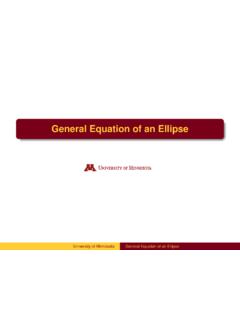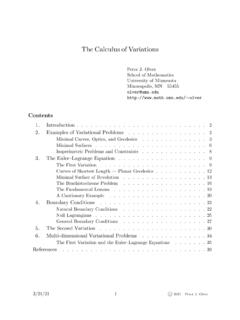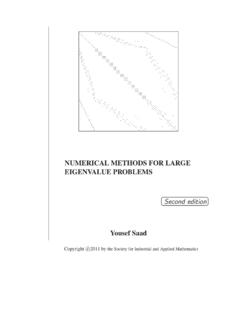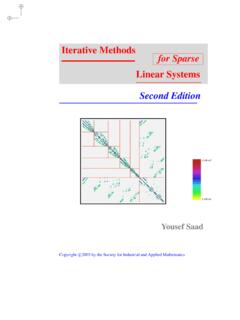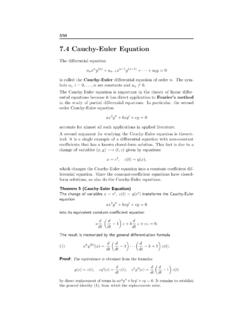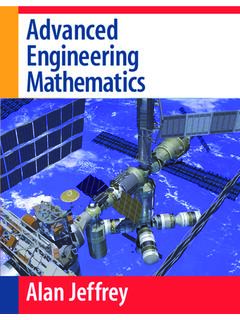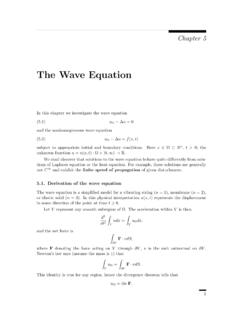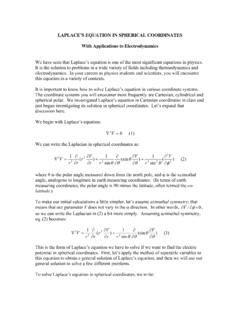Transcription of Complex Analysis and Conformal Mapping
1 Complex Analysis and Conformal Mappingby Peter J. OlverUniversity of MinnesotaContents1. Introduction.. 22. Complex Functions.. 2 Examples of Complex Functions .. 53. Complex Differentiation.. 9 Power Series and Analyticity .. 124. Harmonic Functions.. 15 Applications to Fluid Mechanics .. 205. Conformal Mapping .. 27 Analytic Maps .. 27 Conformality .. 33 Composition and the Riemann Mapping Theorem .. 38 Annular Domains .. 426. Applications of Conformal Mapping .. 44 Applications to Harmonic Functions and Laplace s Equation.. 44 Applications to Fluid Flow .. 48 Poisson s Equation and the Green s Function ..537. Complex Integration.. 56 Cauchy s Theorem .. 61 Circulation and Lift.
2 65 Cauchy s Integral Formula .. 71 Derivatives by Integration .. 72 Liouville s Theorem and the Fundamental Theorem of Algebra.. 73 The Calculus of Residues .. 75 Evaluation of Real Integrals .. 80 References.. 861/7/221c 2022 Peter J. Olver1. term Complex Analysis refers to the calculus of Complex -valued functionsf(z)depending on a single Complex variablez. To the novice, it may seem that this subjectshould merely be a simple reworking of standard real variable theory that you learnedin first year calculus. However, this na ve first impressioncould not be further from thetruth! Complex Analysis is the culmination of a deep and far-ranging study of the funda-mental notions of Complex differentiation and integration,and has an elegance and beautynot found in the real domain.
3 For instance, Complex functions are necessarilyanalytic,meaning that they can be represented by convergent power series, and hence are infinitelydifferentiable. Thus, difficulties with degree of smoothness, strange discontinuities, subtleconvergence phenomena, and other pathological propertiesof real functions never arise inthe Complex driving force behind many of the applications of complexanalysis is the remarkableconnection between Complex functions and harmonic functions of two variables, solu-tions of the planar Laplace equation. To wit, the real and imaginary parts of any complexanalytic function are automatically harmonic. In this manner, Complex functions providea rich lode of additional solutions to the two-dimensional Laplace equation, which can beexploited in a wide range of physical and mathematical applications.
4 One of the mostuseful consequences stems from the elementary observationthat the composition of twocomplex functions is also a Complex function. We re-interpret this operation as a complexchange of variables, producing aconformal mappingthat preserves (signed) angles in theEuclidean plane. Conformal mappings can be effectively usedfor constructing solutionsto the Laplace equation on complicated planar domains that are used in fluid mechanics,aerodynamics, thermomechanics, electrostatics, elasticity, and assume the reader is familiar with the basics of Complex numbers and Complex arith-metic, as in [20; Appendix A], and commence our exposition with the basics ofcomplexfunctions and their differential calculus.
5 We then proceed to develop the theory and appli-cations of Conformal mappings. The final section contains a brief introduction to complexintegration and a few of its applications. Further developments and additional details andresults can be found in a wide variety of texts devoted to Complex Analysis , including[1,12,22,23].2. Complex principal objects of study are Complex -valued functionsf(z), depending on a singlecomplex variablez=x+ iy C. In general, the functionf: Cwill be defined on anopen subdomain,z C, of the Complex Complex function can be uniquely written as a Complex combinationf(z) =f(x+ iy) =u(x,y) + iv(x,y),( )of two real functions, each depending on the two real variablesx,y:itsreal partu(x,y) = Ref(z) and itsimaginary partv(x,y) = Imf(z).
6 1/7/222c 2022 Peter J. OlverFor example, the monomial functionf(z) =z3can be expanded and written asz3= (x+ iy)3= (x3 3xy2) + i (3x2y y3),and soRez3=x3 3xy2,Imz3= 3x2y of the well-known functions appearing in real-variable calculus polynomials,rational functions, exponentials, trigonometric functions, logarithms, and many more have natural Complex extensions. For example, Complex polynomialsp(z) =anzn+an 1zn 1+ +a1z+a0( )are Complex linear combinations (meaning that the coefficientsakare allowed to be complexnumbers) of the basic monomial functionszk= (x+ iy)k. Complex exponentialsez=ex+ iy=excosy+ iexsiny,are based onEuler s formula, and are of immense importance for solving differential equa-tions and in Fourier Analysis .
7 Further examples will are several ways to motivate the link between harmonicfunctionsu(x,y), meaningsolutions of the two-dimensional Laplace equation u= 2u x2+ 2u y2= 0,( )and Complex functionsf(z). One natural starting point is the d Alembert solution formulaof the one-dimensional wave equation see [20] which was based on the factorization = 2t c2 2x= ( t c x) ( t+c x)of the linear wave operator. The two-dimensional Laplace operator = 2x+ 2yhasessentially the same form, except for an ostensibly unimportant change in sign . TheLaplace operator admits a Complex factorization, = 2x+ 2y= ( x i y) ( x+ i y),into a product of first order differential operators, with Complex wave speeds c= i.
8 Mimicking the d Alembert solution for the wave equation, weanticipate that the solutionsto the Laplace equation ( ) should be expressed in the formu(x,y) =f(x+ iy) +g(x iy),( ) , a linear combination of functions of the Complex variablez=x+ iyand its complexconjugatez=x iy. The functionsf(x+ iy) andg(x iy) formally satisfy the firstorder Complex partial differential equations f x= i f y, g x= i g y,( ) Although this trivial change in sign has significant ramifications for the analytical propertiesof (real) 2022 Peter J. Olverand hence ( ) does indeed define a Complex -valued solutionto the Laplace most applications, we are searching for real solutions, and so our Complex d Alembert-type formula ( ) is not entirely satisfactory.
9 As we know,a Complex numberz=x+ iyis real if and only if it equals its own conjugate:z=z. Thus, the solution ( ) will bereal if and only iff(x+ iy) +g(x iy) =u(x,y) =u(x,y) =f(x+ iy) +g(x iy).Now, the Complex conjugation operation interchangesx+ iyandx iy, and so we expectthe first termf(x+ iy) to be a function ofx iy, while the second termg(x iy) willbe a function ofx+ iy. Therefore , to equate the two sides of this equation, we shouldrequireg(x iy) =f(x+ iy),and sou(x,y) =f(x+ iy) +f(x+ iy) = 2 Ref(x+ iy).Dropping the inessential factor of 2, we conclude that a realsolution to the two-dimensionalLaplace equation can be written as thereal partof a Complex function. A more directproof of the following key result will appear in Theorem (z)is a Complex function, then its real partu(x,y) = Ref(x+ iy)( )is a harmonic partof a Complex function is also harmonic.
10 This is becauseImf(z) = Re if(z) is the real part of the Complex function if(z) = i [u(x,y) + iv(x,y)] =v(x,y) iu(x,y).Therefore, iff(z) is any Complex function, we can write it as a Complex combinationf(z) =f(x+ iy) =u(x,y) + iv(x,y),of two inter-related real harmonic functions:u(x,y) = Ref(z) andv(x,y) = Imf(z).Before delving into the many remarkable properties of Complex functions, let us lookat some of the most basic examples. In each case, the reader can directly check that theharmonic functions provided by the real and imaginary partsof the Complex function areindeed solutions to the two-dimensional Laplace equation ( ). We are ignoring the fact thatfandgare not quite uniquely determined since one can add andsubtract a common constant.

